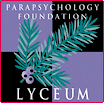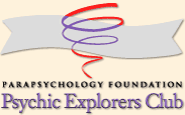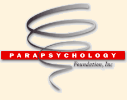 |
 |
| Carlos S. Alvarado, Ph.D. Chairman of Domestic and international Programs Parapsychology Foundation The modern historiography of clinical psychology and psychiatry was deeply affected by Henri F. Ellenberger’s The Discovery of the Unconscious (1970). Not only did Ellenberger provide a detailed discussion of ideas of the unconscious that was unprecedented, as seen in the work of Sigmund Freud, Pierre Janet, and Carl G. Jung, among others, but he also argued that interest in parapsychological phenomena and spiritism was an important contributing factor to the development of ideas of the mind. Ellenberger credited the early mesmerists with observations of phenomena that occurred during the mesmeric trance such as secondary personalities and state specific memory, phenomena which supported the idea of non-conscious levels or layers of the mind. Furthermore, in this context Ellenberger mentioned interest in such phenomena as table turning and mediumship. He was aware of the work of the Society for Psychical Research (SPR) and of the importance of such figures as Frederic W. H. Myers (for links to information on Myers and his own writings click here, and for a bibliography on Myers, click here). While these issues were not the main thrust of Ellenberger’s work, both his prestige as a scholar and his painstaking research opened the door to the positive consideration of psychical research as an influential force in psychology (on Ellenberger’s contributions to the historiography of psychiatry and psychology see Micale, 1993). More recently, others have expanded considerably on Ellenberger. Examples are Alan Gauld’s A History of Hypnotism (1992), and Adam Crabtree’s From Mesmer to Freud: Magnetic Sleep and the Roots of Psychological Healing (1993). Both authors discuss mesmerism and hypnosis, but Crabtree also includes spiritualism and psychical research in his discussion. They have shown that a variety of concepts of the mind, such as ideas of subconscious mental activity, received a significant input from those areas that have been neglected and have been labeled as pseudoscience or simply as peripheral because they were related to parapsychological phenomena. As Crabtree (1993) has argued, all of this research coming from mesmerism and psychical research brought “scientific thinking to bear on phenomena that had largely been reserved for philosophical and theological speculation. And this in turn allowed the development, for the first time, of systematic and effective psychological healing” (p. 280). Furthermore, Crabtree argued following Ellenberger, that “some of the very first speculations on unconscious mental activity” came from attempts to explain table turning (p. ix). Similarly, Crabtree pointed out that studies of hypnosis conducted by SPR members “led to important discoveries about the nature of somnambulistic consciousness” (p. ix). To some extent, Bertrand Méheust’s (1999a, 1999b) two-volume work Somnambulisme et mediumnité (1784-1930) also chronicles some of this, although his emphasis is on the rejection of psychic phenomena by society, and particularly by scientists and scientific institutions. In any case one may argue that the study of something as hypnosis did not progress simply by shedding the parapsychological. Instead students of parapsychological phenomena were actively contributing conceptually even if their claims are not generally accepted today. The dissemination of ideas about the subconscious and about the potential of the mind took place to some extent through psychical research and popular writings on psychic phenomena. Some of this is evident in the writings of Fuller (1986), Powell (1979) and Shamdasani (1993). Eugene Taylor (1996) argued in his book William James on Consciousness Beyond the Margins that the writings of SPR workers “were the main conduit to the United States for the latest developments in scientific psychotherapy in England, the Netherlands, Europe and Switzerland. Through them the earliest work of Pierre Janet on dissociation and multiple consciousness was first corroborated and transmitted to the United States in 1887, and in the early 1890s the British group [the SPR], through James and his Boston colleagues, became the route through which first news of the work of Breuer and Freud on hysteria entered the American psychological literature” (p. 23). There is no question that the efforts of the SPR were influential during the nineteenth century and later in the development of the concept of subconscious selves and of dissociation. A recent article documented the contributions of the SPR workers to the study of dissociation (Alvarado 2002). It was argued that for the 1882-1900 period no other institution in England contributed to our knowledge of dissociation to the same extent as did the SPR. This included the hypnotic work of Edmund Gurney) and the theoretical analyses of Frederic W. H. Myers (e.g., links, bibliography) of the subliminal mind, among other lines of work. For a discussion of Myers’s contributions to psychology see Emily W. Kelly’s (2001) paper. The SPR work was influential on others, as has been briefly argued by Alvarado (2002). Myers’s work was particularly influential. As Taylor (1996) has argued: “Myers’s formulations were ... central to the development of [William] James’s psychology and philosophy in the 1890s, and they form the epistemological core of James’s scientific activities in abnormal psychology and psychical research” (p. 79). Others have argued that Myers influenced American lay psychotherapeutic movements (Powell, 1979) as well as such figures as Pierre Janet (Crabtree, 2003; Le Maléfan, 1999). I (Alvarado, 2004) have presented a short discussion of the reception of Myers’s classic book Human Personality and Its Survival of Bodily Death. Other authors have argued for the importance of the study of psychic phenomena in the development of European psychiatry and psychology. In Folie et Spiritisme: Histoire du Discourse Psychopathologique sur la Pratique du Spiritisme, ses Abords et ses Avatars (1850-1950), Pascal Le Maléfan (1999) argued that French psychiatrists, threatened by the phenomena produced by mediums, reacted by appropriating some of the features of mediumship through the creation of particular psychiatric conditions. While the phenomena were not accepted as paranormal they influenced psychiatry and psychology nonetheless. Further examples of this, Le Maléfan argued, were the discussions of mediumship as examples of “doubling” (dédoublement), or the dissociation of consciousness in mediums. Among those influenced by SPR work and by the phenomena of mediums in their conceptualizations of dissociation, were such figures as Alfred Binet, Pierre Janet and Theodore Flournoy. In Naissannce d’une Science Humaine: La Psychologie: Les Psychologues et le “Merveilleux Psychique”, Régine Plas (2000) argued that the idea of a subconscious mind was intimately connected to the study of psychic phenomena in France. She documented the telepathic (“mental suggestion”) work of Pierre Janet and Charles Richet, among others. In her view, “attempts to understand how thought could be transmitted ... without apparent exterior signs is what affirmed the existence of a substantive and psychic unconscious” (p. 122). Alvarado (2002), Crabtree (1993, 2003), Méheust (1999b), and Shamdasani (1993) argue that psychical researchers have contributed to our knowledge of automatisms. Similarly, the early ESP work of Charles Richet and others contributed to the development of statistical techniques and of randomization procedures in psychology (on this see Hacking [1988], who cannot conceal his distrust and dismissal of psychical research). The point has also been made that a good proportion of the modern psychological studies of out-of-body experiences have been contributed by researchers who worked in the context of parapsychology and published in parapsychology journals (Alvarado, 1992). There is certainly much to be done to study the contributions of psychical research to psychological knowledge. I would argue that parapsychology has contributed actively to the development of concepts of the mind, particularly the mind as a nonphysical agent. The ideas of Myers as well as of such later workers as William McDougall, J. B. Rhine, Robert Thouless and B. P. Weisner, and John Beloff are cases in point. Regardless of the validity of those views, perhaps we should see them as historians do when they examine the philosophical and scientific ideas of Aristotle and Descartes today. That is, regardless of their current validity or acceptance, we can see these ideas as contributions to the intellectual history of our attempts to understand human nature. There have also been contributions to conventional ways to explain parapsychological phenomena that deserve study and recognition. Psychical researchers themselves, and not only their critics, have been active along these lines. This includes fraud (such as the work of Hereward Carrington, and Julian Ochorowicz), problems with human testimony (Edmund Gurney, Richard Hodgson, Eleonor M. Sidgwick, Donald J. West) and phenomena such as hallucinations, automatisms and the creation of secondary personalities (Théodore Flournoy, James H. Hyslop, Enrico Morselli, F. W. H. Myers, and René Sudre). Perhaps one day we will see such parapsychologists as Whately Carington, J.G. Pratt, Charles Stuart, and Charles Honorton credited as contributors to methodologies to measure mentation quantitatively. Furthermore, I would like to see future histories of psychology mention the contributions of parapsychologists to the human potential movement and to the empirical study of the variety of human experience. Future examinations of the work of parapsychologists may extend our understanding to the point that we may see histories that do not trivialize parapsychology work even if the ontological status of our claims has not been resolved. This does not need to be limited to psychology. As seen in some existing works (e.g., Biondi, 1988; Luckhurst, 2002), interest in, and study of, psychic phenomena has interacted with and influenced literature, religion and many practices and beliefs. Alvarado, C. S. (1992). The psychological approach to out of body experiences: A review of early and modern developments. Journal of Psychology, 126, 237-250. Alvarado, C. S. (2002). Dissociation in Britain during the late nineteenth century: The Society for Psychical Research, 1882-1900. Journal of Trauma and Dissociation, 3, 9-33. http://www.parapsych.org/PDF/Alvarado_JTD_Volume_3_2002.pdf Alvarado, C. S (2004). On the centenary of Frederic W.H. Myers’s Human Personality and Its Survival of Bodily Death. Journal of Parapsychology, 68, 3-43. http://www.survival-research.net/downloads/alvarado_myers_jp.pdf Biondi, M. (1988). Tavoli e Medium: Storia dello Spiritismo in Italia [Tables and Mediums: History of Spiritism in Italy]. Rome: Gremese. Crabtree, A. (1993). From Mesmer to Freud: Magnetic Sleep and the Roots of Psychological Healing. New Haven, CT: Yale University Press. Crabtree, A. (2003). “Automatism” and the emergence of dynamic psychiatry. Journal of the History of the Behavioral Sciences, 39, 51-70. Ellenberger, H. F. (1970). The Discovery of the Unconscious: The History and Evolution of Dynamic Psychiatry. New York: Basic Books. Fuller, R. G. (1986). Americans and the Unconscious. New York: Oxford University Press. Gauld, A. (1992). A History of Hypnotism. Cambridge: Cambridge University Press. Hacking, I. (1988). Telepathy: Origins of randomization in experimental design. Isis, 70, 427-251. Kelly, E. F. (2001). The contributions of F. W. H. Myers to psychology. Journal of the Society for Psychical Research, 65, 65-90. Luckhurst, R. (2002). The Invention of Telepathy 1870-1901. Oxford: Oxford University Press. Le Maléfan, P. (1999). Folie et spiritisme: Histoire du discourse psychopathologique sur la pratique du spiritisme, ses abords et ses avatars (1850-1950) [Madness and spiritism: History of the psychopathological discourse of the practice of spiritism, its approaches and avatars (1850-1950)]. Paris: L’Hartmattan. Méheust, B. (1999a). Somnambulisme et mediumnité (1784-1930): Vol. 1: Le défi du magnétisme animal [Sonambulism and mediumship (1784-1930): Vol. 1: The challenge of animal magnetism]. Le Plessis-Robinson: Institut Synthélabo pour de Progrès de la Connaissance. Méheust, B. (1999b). Somnambulisme et mediumnité (1784-1930): Vol. 2: Le choc des sciences Psychiques [Sonambulism and mediumship (1784-1930): Vol. 2: The crash of psychic sciences]. Le Plessis-Robinson: Institut Synthélabo pour de Progrès de la Connaissance. Micale, M. S. (Ed.) (1993). Beyond the Unconscious: Essays of Henri F. Ellenberger in the History of Psychiatry. Princeton, NJ: Princeton University Press. Plas, R. (2000) Naissannce d’une science humaine: La psychologie: Les psychologues et le “merveilleux psychique”[The birth of a human science: Psychology: The psychologists and the “psychic marvellous”]. Rennes: Presses Universitaires de Rennes. Powell, R. C. (1979). The “subliminal” versus the “subconscious” in the American acceptance of psychoanalysis, 1906-1910. Journal of the History of the Behavioral Science, 15, 155-165. Shamdasani, S. (1993). Automatic writing and the discovery of the unconscious. Spring, 54, 100-131. Taylor, E. (1996). William James on Consciousness Beyond the Margin. Princeton, NJ: Princeton University Press. |
 |

|
 www. parapsychology. org |
||